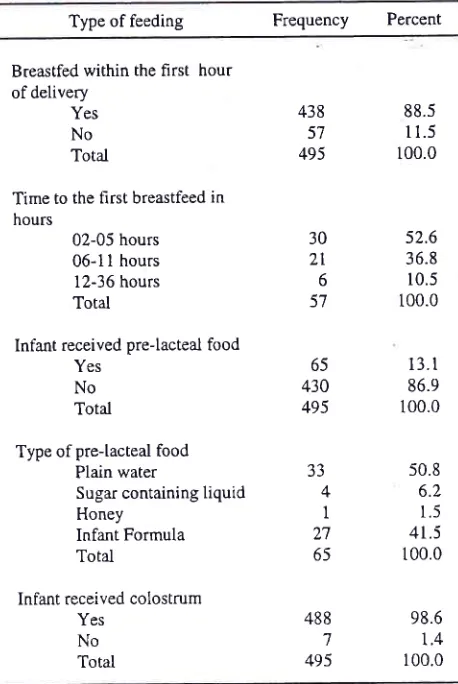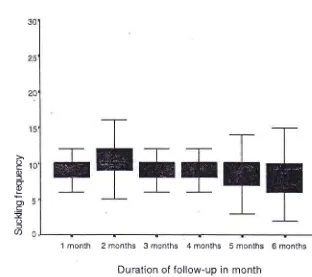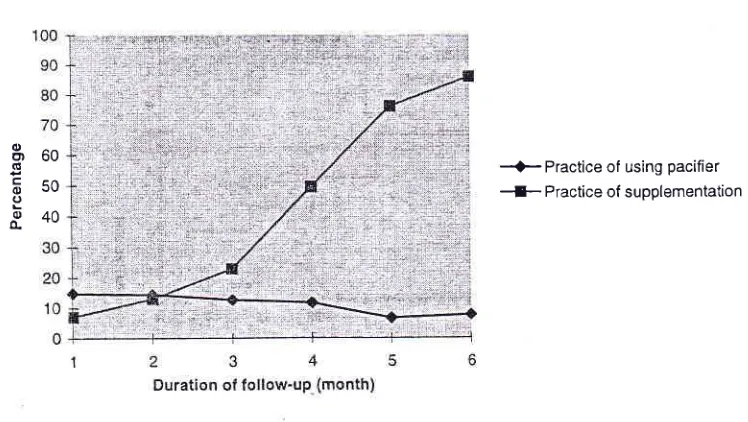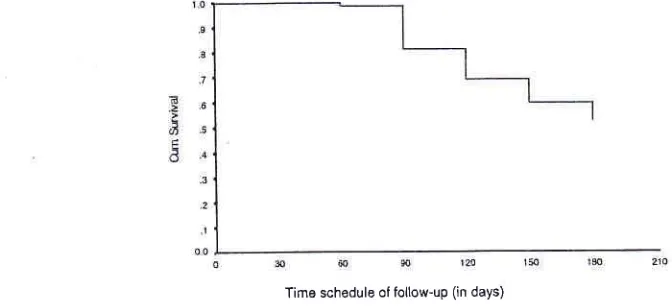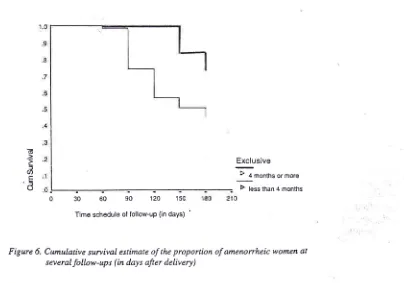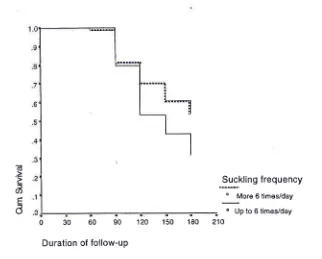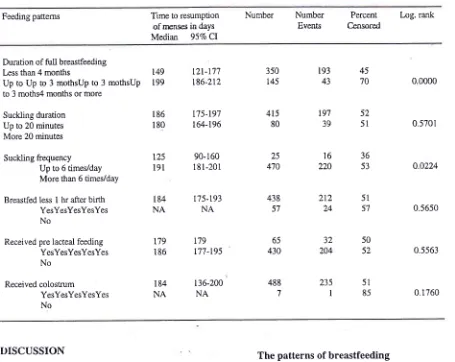lôÈ'
Tartgan Med J IndonesThe patterns of breast-feeding and
their
effect on the
time of resurnption
of
rnenses
Lukman Hakim Tarigan
Abstrak
Persentasi ibu yang menyusui secara elcsklusif pada empat bulan pertamn setelah persalinan adalah 50To, dan kurang dari I 5Vo yang meneruskan sampai dengan 6 bulan. Rata-rata lama menyusui secara elcsklusif adalah 3,3 bulan. Median waktu mendapatkan haid setelah persalinan adalah 186 hari (CI: 177-195). Median waktu mendapatl<an haid berhubungan secara bermalçta dengan lama menyusui secara elcsklusif dan juga dengan rata-rata frekuensi menyusui. Hubungan tersebut berbanding lurus. Median waktu mendapatkan haid pada ibu menyusui secara elcsklusif sampai dengan tiba bulan dan yang menyusui 4 bulan atau lebih masing-masing adalah: 149 (CI: I2I-177) hari dan 199 (CI: 186-212) hari. Pada responden yang menyusui sampai dengan 6 kali perhari mediai wakru mendapatkan haid adalah 125 hari (CI: 90-160), sementara yang menyusui 6 l(ali anu lebih per hari adalah 19I hart (CI: I 8 I -20 1 ). (Med J Indones 2002; 11 : 106-19)
Abstract
The percentage of mother who had fulL/exclusive breast-feeding for four months after birth are 50Vo, and only less than l5%o continuedfuIl/exclusive breast-feeding for up to the first six months afier birth. The mean duration of full/exclusive breast-feeding is 3.3 months. The median time of the resumption of menses in this study is 186 days (CI: 177-195 days). The median ime of resumption of menses significantly associated with both the mean duration of fuIl/exclusive breast-feeding and the average suckling frequency.
ih"
longq the mean duration of fulL/exclusive breast-feeding and the more the avera1e of sucklingfrequency, the longer the median time of resumption of menses. The median time of resumption of menses in respondent who practiced fulUexclusive breast'feeding up to three and more than three months are 149 (CI: 121-177) and 199 (CI: 186-212) days, respectively. And in the mothers who breast fed their infant for up to six times and more than 6 times per day the median time of resumption of menses are 125 (CI: 90-160) and191 (CI: 181-201) days, respectively. (Med
t
Indones 2002; 11: 106'19) Keywords : breastfeeding, lactational amenonhoea, resumption of mensesThe
effectivenessof
using
breast-feedingas
anindividual
contraceptiveor
child
spacing method (known as the lactational amenorrhoea method-LAM) and the main factors that correlate to the timeof
the resumptionof
menses arestill
controversial. Several studies reported different figures: some of them were optimistic about thechild
spacing effectof
breast-feeding and thus used theLANI
asa
partof
their contraceptive program, while others were still looking for more evidence.At
the intemational conferencein
Bellagioin
1988,leading
researchersin
the
areasof
lactational infertiliry reached a consensus that the maximum birthDepartment of Epidemiotogy, Faculty. of PubLic Health University of I nln ne sia. D ep o lç I ndo ne s ia
fulfilled,
breast-feeding providesmore
Than 98To protection from pregnancy in the first six months.l'2Further research revealed that the contraceptive effect
of
lactational amenorrhoea(LA)
not only occured in women who- fulty breasrfed but alsoin
women who partially breast-fed, irrespectiveof
the supplements that were introduced into the baby's diets.In practice,
ferver than 257oof
mothersfully
breast-fedfor
6 months.3The
pregnancy rates reporiedduring
[A
ranged from 0.4 lo 6Vo \nthe first 6 months.3'a'sVol 1 I, No 2, Apil
-
June 2002greater than the probabiliry of other modern methods of contraception.
In
Indonesia the percentageof
wornenin
theI-A
take another
e
pill
and 10.1e over-protecfiv
stated that the inLroduction of contraceptives early in the postpartum period had virnrally no demographic impact, and a considerable proportion of the potential effect of contraceptive practice would be wasted.
There are several factors that might affect the duration of the LA period such as the duration of fulVexclusive breastfeeding, the frequency
of suckling, the
averageduration of a suckling episode, time of introduction of supplementary
food, the
practice andtype of pre
lacteal food, the practiceof breastfeeding
within the first hour of birth, rooming in, age of mother, parity, the mother's nutritional status, educational and socio-economic status. e'15This study objectives are
to describe
the pattern of breasfeeding among mothers who initially breastfedd their child, and to estimate the relationship between breastfeeding pattern and the timeof
resumption ofmenses.
METHODS
Research methodology and subjects
This study involved a cohort
to
diminish the recall bias andto
avoidthe
ambiguityof
tirne sequencerelationship.
To
enableus to observe
mostof
theevents
of
interest, a long time follow-up (at least 9months) was needed, however resources and time were
limited. Therefore the follow-up took only six months
and based on monthly follow-up.
By
this six month studyit was expected
to observe more than half of the events of interest (the resumption of menses) to occur.All
womenwho
were
at
34
or
more week
of pregnancy, attended the antenatal clinic (ANC), andintended to deliver at the Puskesmas which provided delivery service were asked
to
participatein
thisstudy. Volunteer mothers who intended to breasrfeed
and agreed to long term follow-up on a monthly basis,
and who met the inclusion criteria'were interviewed face-to-face.
The
second interview was conducted immediately at the Puskesmasin
thefirst
72 hoursThe patterns ofbreast-feedinC 107
after delivery before discharged.
The midwife
hadpromoted
the
breastfeedinginformation
to
the mothers before discharged and then reminded them to come for the next interview ai the out patient clinic atthe Puskesmas along with her child in the next month. The midwife always reminded the mothers to come to the out patient clinic
for the
next interviewin every
visit until six time visits.Inclusion
criteria
The inclusion criteria
for subjects
were: women who intendedto
breastfeedtheir
childrenat
least six months, aged 16 -39 years at the time of delivery, had no previous historyof
infertiliry and no gynecologic abnormality, had a vaginal delivery at term, and had ahealthy
child whose
birth
weiglit was at least 2500 grams.In
addition,
they should
deliver in
the puskesmas, agree to use either condom or intra uterine device(IUD)
for contraceptive
purpose during thesrudy period and were accessible for follow-up.
Exclusion
criteria
The exclusion criteria
for
thissildy
was: the mother intentedto
use hormonal contraception before the resumption of menses.Discontinuation
criteria
A woman
engagedin
this study was excludedin
thefollowing circumstances: serious illness
or
death of the mother and/or infant, non attendance at follow-up interviewsfor
thefirst
threeor
more months con-secutively, used hormonal connaception (pills, injecdon, or implant) before the resumption of menses, had vaginal bleedingfor
more thanfifty six days since delivery,
pregnancywhich was
confirmedby
biochemical examination, and lochia persisted for more than 40 days.Study end points
The occunence of an episode of vaginal bleeding or sponing after 56 days poslparnrm regardless the mother
had or not perceived to have a normal rnensfuation.
Sampling
'!
108
Tarigan-the highest number of deliveries (at least 50 deliveries per month) were then selected from the areas. The collecting of respondents was ended when the sample size needed was
fulfilled.
The exposure group wasfully/exclusively breastfeeding mothers, whereas the
unexposed
group
wasthe
motherwho
were not fully/exclusively breastfed their child.Sample size
The total number of subjects required is dependent on the information needed about the study outcomes (the time
of
resumptionof
menses)'r6't7 The study designwas
a
single cohort. The follow-up time varied for each patients,the
exacttime
until
the
event of outcome for subjects who failed to come at follow-up couldn't be estimated, and the timeto
resumption of menses might not be normally distributed. Therefore, estimating sample size by comparing "survival time" in groups is needed. The sample size was determinedty using the
POWER progra-.ttThe estimated sample size required
for
each group was 117 subjects. This sample size is needed, if thestudy is
to
detect a differenieof
eight weeksiri
the median durationof LA
betweentwo
equal sizedgroups by using two-sided significance tests at the 5Vo probabiliry level with statistical power of 807o, accrual time 3 months, and follow-ups at 3,4,5, and 6 months.
The
prevalenceof full
and partial
breastfeeding changes over month. From a previous study,in the
first month the prevalence offully
breastfeeding wasaround '77Vo
and
decreasedalong
with
time
to approximately 257oin
the first six months and didn't decrease anymore thereafler. Therefore, 500 subjectsshould be enrolled to provide 1 17 subjects
in
the full breastfeeding groupin
a 6-month study. However,
when 500 subjects are used, there is a possibility that unequal sized groups willbe
achieved. The power estimationfor
unequal sample sizes .would then beperformed, using the lachin's equation.rE
Data management
A
field supervisor visited and collected the data from the Puskesmas every month. Rechecking and coding data were carried out in the field. The field supervisor ascertained whether the interviewer made a mistake infilling
in
the questionnaire, andif
so a re-interview was organized.Med J [ndones
Data collection and coding
The data was collected by means of questionnaire and
by faceto-face interviews. lnterviews were conducted
by
the trained
midwives
of
the
Puskesmas. A1l interviews (eight times) except the second interview could be conducted either in the public health centre or at home.If a
mother had missed an appointment atthe out patient
clinic, a
midwife visited herat
herhome. The midwife then persuaded her to continue in the study after the interview ended.
Data analysis
The number
of
respondentswho
were still in thestudy, failed to come at follow-up (excluded), or got the resumption
of
menses (an event) were reported monthlyby
usinga
life
table analysis. The subjectswere divided
into two
grouPs:the
fulVexclusive breastfeeding up to three months and more than threemonths
after birth.
This study
recorded
serial measurementsof
the
same variableson the
sameindividual at several points in time (six times follow-up visits). The variables were the suckling frequency and the duration
of
suckling episode. Such data wereanalyzed by calculating the means and standard deviations
(SD). The Kaplan-Meier tife table method was used to
determine ttre median time
to
the first Irpnses on eachindependent variable,
with a
women being excluded from the life table when lost to follow-up.This method was used since the follow-up time of respondents varied
for each patient and
the
exact follow-up time of subjects who were lost to follow-up couldn't be estimated.The relationship between the time
of
resumption ofmenses and several selected variables of breastfeeding patterns such as, the duration of suckling episode, the
ir"qu"n"y
of
daily
suckling,the
durationof
fulV exclusive breastfeeding, the timeto
thefirst
breast-feeding, practice of pre lacteal food, and type of pre lacteal food were analyzed using the Log rank test.
RESULTS
Among the 600 mothers who agreed to participate in this study, 559 mothers were eligible but during the stucly 64 responclents were excluded for the following reasons. Thirty respondents used hormonal contraception
Vol I l, No 2, April
-
June 2002used the hormonal injection, and three respondents used the combined
pill
of contraception), seven respondentswere bleeding
for
morethan
56
days following delivery, and27 respondents were lost to follow-up.The number
of
respondentsin
the study at the first month of follow-up was 495, and then decreased to489 in the second month, since six of the respondents
had resumed their menses between the 56ù and 60ft
days. The number
of
respondents includedin
thefollow-up study decreased with time. There were 200
respondents
still
in
the studyby
the endof
the sixmonths (see Table 1).
Table
l.
Numberof
respondents at the start of each time interval and number of withdrawal and eventsTime
intenral
Numberof
Number of afterdelivery
subjectsat
withdrawals(days)
the startof
during time timeinterval
intervalNumber with return
of menses
00-29 30-59 60-89 90-l 19
t20-t49 150-179 180-209 495 495 489 398 325 269 200 0 0 5 l4 t4 40 186 0 6 86 59 42 29 t4
The pattern of infant feeding
The feeding practices reported were the pattern of infant feeding within the first three days after delivery
and after the type of infant feeding, and the timing of introduction of different types of supplementary food.
The patterns of feeding within the first three days
after delivery
Breastfeeding characteristics
in
thefirst
three daysafter delivery included the time to the initial
breast-fèeding after birth, the practice and type of pre-lacteal
feeding, and the practice of discarding colostrum.
All
of the infants received breast milk in the first 36 hoursafter delivery, and among them 88.57o received breast
milk in the first hour after delivery.
The proportion
of
infantswho
received pre lactealfood was L3.l%o. Among those infants who received
pre lacteal food, half of them received water. Others
The patterns of breast-feeding 109
received pre lacteal feeding containing calories such as: sugar containing liquid, honey and infant formula. Infant formula was
the second rnost popular
pre-lacteal food rype and was given to 4l.5Vo of infants in
the study. The practice of discarding colostrum in lhis study was relatively low (see Table
2).
Refening tothe
practiceof
the
first
breastfeeding,it
can -beconcluded that most
of
the
respondents practiced giving colostrumto the infant
in
the first hour afterbirth.
However,this
study
did not
measure thequantily of the pre lacteal food.
Table 2. Patterns ofinfant feeding during the first three days
after delivery
Type of feeding
Frequency
PercentBreastfed within the first hour of delivery
Yes
No Total
Time to the first breastfeed in
hours
02-05 hours
06-11 hours
l2-36 hours
Total
Infant received pre-lacteal food
Yes
No Total
Type of pre-lacteal food Plain water
Sugar containing liquid Honey
Infant Formula Total
Inlant received colostrum
Yes No Total 65 430 495 438 57 495 30 2l 6 57 JJ 4 1 27 65 488 7 495 88.5
I 1.5 100.0
52.6 3 6.8 10.5 100.0
13. I
86.9 100.0 50.8 6.2 1.5 41.5 100.0 98.6 1.4 100.0
Infant feeding practices during the first six months of life
The
percentageof
the
respondentswho
initiated breastfeedingin
the
first
month was foundto
be 100.70, but the proportion of respomdents continuing to breastfeed gradually decreased to 99.IVo in the six [image:4.612.307.536.294.636.2] [image:4.612.48.284.321.511.2]I
10
TariganInfants tffere generally breastfed on demand during the day as well as at night. The proportion of respondents
who
breastfedtheir infant
on
demandin
the
first month was 98Vo, and only afew
of
them breastfedtheir infant
on
schedule.-Night
feeding was very commonin
this study. Almostall of
the respondents breastfed their infants at night. [image:5.612.145.457.363.640.2]The average suckling frequency was determined, by asking the respondents how many times she breastfed her child for the day prior to her visit to the clinic. The
average
suckling
frequency started
slightly
to decreasefrom the
6'd
monthsafter
delivery (see Figure 1).In
this study, the respondent was asked to recall the duration of each suckling episode at the day prior to coming to the clinic.In
the first three month after delivery the mean durationof
suckling episodes was 16.7 minutes and ranged between5
minutes toMed J Indones
more than
30
minutes per episodes.By
the
fourth monthafter
deliverythe
mean andthe
range of suckling duration decreasedto 14
minutes/episode and from5 to
20 minutes, and by the sixth month after delivery, the mean suckling duration was 13.0 minutes/ episode (see Figure 2). Although supplementary fogdis
hot
recommendeduntil
an
infant
reaches four monthsof
age,it was
introduced much earlier. The proportionof infants receiving
supplementary food increased rapidlywith
time. OnIy l3Vo had already received supplementary foodin
the first two months of age, and this gradually increased up to 867o by six monthsof
age. Almost 50Voof
infants had received some supplementary foodin
thefirst
four months of life. Therefore, the proportion of the respondents who werefull
breastfeedingin
thefirst
four months was 507o, and then decreased to less than l5Vo in the first sixth months after delivery.o 0) =
o
oo) .c
=
of,a
Duration of follow-up
in
monthFigure l. The mean suckLing frequency by duration of follow-up in months after delivery 'l month 2 months 3 months 4 months 5 months 6 months
Vol I 1, No 2, April
-
June 2002The
practice
of
using
a
pacifier was
relatively constantin
thefirst
two months after delivery andthen
slightly
decreasedat
thethird
and the fourthmonth,
but
sharply decreasedby
half
in
the fifthThe patterns of breast-feeding 111
month. In the first months after birth the percentage of infants using a pacifier was 14.8 and this decreased
with age to']. .1Vo in the first six months (see Figure 3).
*Practice
of using pacifier-I-
Practice of supplementationc
.o
Ero
f!
o)
CÂ
=
o3A0
[image:6.612.117.517.76.375.2] [image:6.612.111.485.492.703.2]Duration of follow-up in months
Figure 2. The mean suckling duration by duration of follow-up in months after delivery
8'
60(E
L ÊA
oJv o
340
Figure 3. Percentage of breastfeeding mothers who introduced ntpplementary food or pacifier to
their infants at different age (in months)
-l
ll2
TariganIn
Figure
4
the. percentageof
each
tyPe
of supplementaryfoods
that the
infant
received ispresented monthly from the time
of
discharge from the Puskesmasto
the sixth month after delivery. Inthis study the infants
in
thefirst two
months weregiven many types
of
supplementary foods such as solid food,*.milk
other than breastmilk
and liquids. The proportion of mashed rice or steamed rice, fruits,and
milk
ponidge increasedwith
time but banana,The median time to resumption of menses and their determinants
The
association betweenthe
mediantime
of
theresumption
of
menses and breastfeeding pattems isshown
in
Table5.
Almost 20Voof
the respondentsMed J Indones
infant formula and condensed
milk
decreased with time.Milk
porridge was preferredat
the 3'd month after delivery, and increased to more than 607o in the 4ù month after delivery. Banana was the most popular supplementary food in the first month of life, followedby infant formula. The use of milk porridge and fruits
increased from 8-67o and 2.9Vo
in
the first month to 60.5 and 59.27o, respectively in the sixth month.*Banana
+-hice
poriiàgeMashed or steamed rice Fruits
+Milk
porridge*lnfantformula
*Condensed
milk2
3 ,4
s [image:7.612.154.479.247.412.2] [image:7.612.108.444.552.705.2]Duration of follow-up inmonths
Figure 4. Percentage of infant receiving supplementary foods and the type of supplementary food by months afier delivery
80 70
"60
cn
gso
c0)
940
o
À30
20resumed their menses by the 90ù day after delivery, 30Voby the 120û day, and 4OVoby the 150ù day after
delivery.
Almost 6O7o
of
the
respondents resumed their menses by the end of the study (see Figure 5).Time schedule of follow-up (in days)
Figure 5. Cumulaive survival estimate of the proporrion of amenorrheic breastfeeding mother at
several follow-ups (in days after delivery)
-t
VoI
Il,
No 2, April- Iune 2002The median time to the resumption of menses and infant feeding characteristics
There were
six
feeding characteristics analysed toassess their effect on the median time to resumption of
menses. Those characteristics were the duration of
full
breastfeeding,the
averageduration
of
suckling episode, the average suckling frequency, the practiceof
breasrfeedingwithin
thefirst
hour after-birth, the practice of giving pre lacteal food, and the practice of discarding coloslrum. For this analysis, some -of thebreastfeeding characteristics were grouped
into
two categorises such as: the duration offull
breastfeeding,the
average durationof
suckling episode, and the average frequency of suckling/day. The duration of fulVexclusive breastfeeding ranged from0
to
6months
and
was categorisedinto two
groups ie.fulVexclusive breasrfeeding for less than four months and the full breastfeeding
for
fouror
more months. The average suckling duration ranged from 7.5 to 30minutes/episode, and was categorised into two groups, ie. suckling
duration
up to 20 minutes and suckling duration more than 20 minutes. Likewise, the averagesuckling frequency was categorised into two groupi ie. suckling frequency up
to
six" times and suckling frequency more than six times per day.The patterns of breast-feeding
lI3
The cumulative survival estimate of the resumption of
menses between mothers who were
full
breastfeeding for less than four months and mothers who werefull
breastfeedingfor
four months or more are presentedin
Figure 6. The estimatefor
the numberof
women with the resumptionof
menses among those mothers who werefull
breastfeeàing for less than four months started to increase at the 57h day, whereasin
thosemothers who were
full
breastfeeding for four or more months, the number of women with the resumptionof
menses started to increaseat
the
120ù day. The cumulativesurvival
of
motherswho
were
full
breasrfeeding for less than four months and who werefull
breastfeeding for four or more months by the end of this study were 39Vo and 64Vo, respectively.The number of respondents who were lost to follow-up or had the resumption of menses between mothers who practiced
full
breastfeedingfor less than four
months and for four months or more was presented in Table3.
Six
of the respondents
who practicedfull
breastfeeding less than four months had the resumption of menses at the 60h day after delivery, whereas therewere no respondents who practiced
full
breastfeeding for four or more months had the resumption of menses at the 120h day after deliveryfigure
6).Exclusive
I 4 months or more
È less than 4 months 30 60 90 120 15C
Time schedule of follow-up (in days)
Figure 6. Cumulative survival estirnate of the proportion of amenorrheic women at
several follow-ups (in days after delivery)
6 .è È
a
Eô
[image:8.612.135.544.452.735.2]ll4
TariganIn the first three months of follow-up ihe cumulative
survival estimate
of
the
numberof
arnenonhoeic womenin
breastfeeding mothers who suckled theirinfant
for
upto
six times per day and mothers whosuckled their infant
for
more than six times per daywas approximately equal. However,
in
the first fourmonths, the esrimate
for
the numberof
women withthe resumption
of
menses among those mothers who0
30 60 90
120Duration of follow-up
Table 3. presents the association between the median
time to the
resumptionof
menses andthe
infantfeeding patterns.
The
longerthe
durationof full
breastfeeding, the longer was the median time
of
theresumption
of
menses.There was
a
statisticallysignificant difference
in
the
mediantime
to
theresumption of menses between mothers who were
full
breastfeeding
for
less thanfour
months comparedwith mothers who were
full
breastfeeding for four or more months.Med J Indones
suckled their infant up to six times per day decreased
more sharply than for those mothers who suckled their
infant more than six times per day. Almost 507o of the
respondents who suckled more than 6 times per day had not resumed their menses by the end of the study, whereas only 30Vo of the respondents who suckled up to six time per day had not resumed their menses by
the end of the study (180 days) (Tigure 7).
.Suckling frequency
o More 6 times/day ' Up to 6 times/day
r50 180
210The result of the association between the median time
to the resumption of menses and the remaining infant
feeding patterns are reported
in
Table3.
For
the remaininginfant
feeding
patterns (between thevariables), there was no significant difference
in
themedian
time to
resumptionof
menses.For
somevariables
of
the infant feeding pattems, the mediantime to the resumption of menses was not abte to be
calculated.
r
[image:9.612.158.480.234.493.2]è
6
Eô
-,!
Vol I I, No 2, April
-
June 2002Table 3. The median time to resumption of menses by infant leeding patterns
The patterns ofbreast-feeding I 15
Feeding pattems Time to resumption
of nenses in days
Median
95Vo ClNumber Number
Events
Percent
Log. rankCensored
Duration of firll breastfeeding Læss than 4 months
Up to Up to 3 mothsUp to 3 mothsUp to 3 moths4 months or more
Suckling duration Up to 20 minutes
More 20 minutes
Suckling frequency
Up to 6 cimes/day
More than 6 times/day
Breastfed less I hr after birth
YesYesYesYesYes
No
Received pre lacteal leeding
YesYesYesYesYes
No
Received colostrum
YesYesYesYesYes No t49 r99 186 180 t25 t9l 184 NA 184 NA Lzl-177 186-2t2 r75-197 t64-t96 90-160
1 8 l-201
t75-t93
NA
179 177 -195
136-200 NA 350 t45 25 4',10 438 57 65 430 488 7 t93 43 t9'l 39 32 204 235 I 45 70 52 51
0 0000
4r5 80 t6 220 2t2 24 36 53 0.5701 0.0224 0.5650 0.5563
0. I 760 t79 186 51 51 50 52 51 85 DISCUSSION
Many studies have been conducted overseas to assess
the relationship between the resumption
of
mensesand the breastfeeding pattem among full breastfeeding and non breastfeeding women. The main aim of these
previous studies was to
find
out the effectiveness orthe
possibility
of
using
breastfeedingas
a contraceptivemethod
known as
the
Lactational Amenorrhoea Method (I-AI\O. This study was primarilyconducted to assess the relationship between the time of the resumption of menses and the yarious variables
of
breastfeeding patterns,in
mothers who werefull
breastfeedingfor
less than four months and for four months or more. Bearing this in mind, we discuss the resultsof
this
study by comparing themwith
the resultsof
previous studies. The breastfeeding pattern and the survival estimate of the time of resumption of menses andthe
factors affectingit
are discussed' Finally, based on the above information, the appropriatetime for
the
introductionof modern methods of
contraception can be determined.The patterns of breastfeeding
As
in
other developing countdes,the
practice of breasfeedingin
Indonesiais
common but relatively longer compared with those 'countries.This
study found that overall
the breastfeeding patterns werebetter
than
the
results
of.
previous study.
The percentage of respondent who initiated breastfeeding, was 1007oin the
first
month afterbirth
and wasrelatively constant (99Vo) in the
first
six rnonths after delivery.The
resultsof
this
study, however, only reflectedthe
percentageof
respondentswho
had intended to breastfeed and had received breastfeeding information. Therefore, this resultscould
not
begeneralised to all breasrfeeding mothers.
Breastt-eeding
the
infants immediatelyor
within
30 [image:10.612.48.503.120.482.2]tiiirr'-r
-116,
Taiganaddressed, namely:
the
breastmilk
hadnot
comethrough yet, or the mothers were tired after delivery.
This
study
found
a
srgnificanthigh
number ofrespondents who introduced breastfeeding within 60
minutes
of ôirth
(88.5Vo).More
rhanl\Vo
of
therespondents delayed
the
practiceof
breastfeeding.This might be caused by oxytocin given to a number
of the respondents during delivery which could delay
the onset of breast milk production.
The
delayof
the
introductionof
breastmilk
orbreastfeeding in the first hour after delivery, can lead
to the introduction of pre lacteal feeding.
If
the motherdelay breastfeeding, the infant
will
be hungry andcrying.
If
so, the
motheror
the family
tend
to introduce pre .lacteal feeding earlier.
The
smallnumber
of
mothers who practised giving pre lactealfood
in
this study might be dueto
the delayin
thebreast
milk
production. However, comparedto
theresults
of
previous studiesin
which the practice ofgiving pre
lacteal feeding wasvery
common, thepercentage of mothers practicing pre lacteal feeding in
this study was very low.
The practice
of
discarding colostrum wasnot
onlycommon in many areas in Indonesia, but also in many
other developing countries.
Budi
Utomo
stated anumber
of
reasons for discarding colostrum, namely:colostrum was considered stale,
dirty
and "watery",and
to
have bador
bitter taste.leIn
this study the percentageof
respondentswho
discarded theircolostrum, however, was very small, only I.4Vo.There
are some reasons which can explain this figure, such
as: breastf'eeding had been promoted
to
the mothersduring the pregnancy, or the health provider did not
allow the
introductionof
pre
lactealfood.
In
this study, the doctors, nurses and mrdwives were asked to persuade the mothers to give colostrum to their infantsand were also asked not to provide infant formula in
their Puskesmas.
The practice of breastfeeding at night ivas common in
many parts
of
Indonesia and also mostof
the infantswere breastfed
on
demand.This
study's findingsconfirmed the previous study results. The percentage
of
respondents practisingthe
use
of a pacifier,
however, was considerably high, especially wiihin the
first month of age.
The suckling frequency
is
relatedto
the volume of breastmilk,
the durationof full
breastt'eeding, theMed J Indones
time
of
the resumptionof
menses, and the time of resumptionof
ovulation.The
more
the
sr-ickling frequency,the
higher
the
stimulation
for
milkproduction, and the longer the resumption
of
mensesis.
The
minimum averageof
suckling frequencywhich had contraceptive effect varied from one study
to another. One study reported that 5 times suckling
day and night had a contraceptive effect, but others found
6
times suckling per day was needed.In
thisstudy, the average suckling frequency was more than
6 times per day, so the minimum suckling frequency
for
having contraceptiveeffect
was achieved. Thenumber
of
respondentswho
breastfed less than 6 timesiday was very small, and there mightnot
beenough variance to
find
out the contraceptive effectbetween these categories.
This study showed a reversal findings; the older the
infants the less the suckling frequency. The decrease
in suckling frequency with time was reasonable, since
the older the infant, the more the supplementary food
was received, and then
the
lessthe
frequency of suckling.By
the same reason,the
decreasein
the average suckling duration with time could be explained.The supplementary food
is
introduced very early ininfancy in lndonesia. This study result confirmed the previous study resultse'r 1,20
in
which
l3Vo
of the
infants received supplementary feedingin
the firstmonth, and the supplementary feeding was gradually
increased with time. Almost 50Vo of the infants already
received supplementation
in
thefirst
four months ofage. The reason for introducing supplementary feeding
in
thefirst
monthsof
age was: breastmilk
did not come out. Further, in the older infant age the reasonswere; the breast
milk
volume was decreased, so themother,
felt
that
breastfeeding wasnot
enough tonourish the infant,
or
the infant refusedto
suckle. Banana was the most popular in the first month of ageand followed by infant formula.
This
study
found
that
rhe
prevalenceof
futlbreastfeeding was higher than the previous study's
results.
In
this study more than 907oof
the motherswere full breastfeeding in the first month after delivery,
and this was declined
with
timeto
50Voin
the first four monthsof
age, and then decreasedio
less thanl3Vo in the first six monrhs afte r birth. This study also found that the median
of
the durationof
full
breast-feeding was longer(3.0
months) comparedro
the-l
Vol I I, No 2, Aprit - June 2002
full
breasrfeeding and the long duration offull
breast-feeding was due to the inclusion criteria in this study.
The
time
of resumption
of
rnensesand
theirpotential risk factors
The
association betweenthe
mediantime
of
theresumption
of
menses andthe
paffernsof
breast-feeding have been conducted
in
many countries andthe results are different from country to country, and
from one study
to
another study. The difference instudy designs, and in operational definition of the first
menses,
full or
exclusive
breastfeeding, andsupplementation could cause these discrepancies. In
this
study,the
termof full
breasrfeeding was useinstead
of
exclusiveor
predominant breastfeeding,and
the
first
menses was definedas any
vaginalbleeding that occurred 56 days after delivery.
The
time
of
the
first
resumptionof
menses wasoccurred within the 57b and 60h day among mothers
who were
full
breasrfeeding for less than four months,and at the 120'h day among mothers who were
full
breastfeeding
for
four months or more. This findiùgconfirmed the previous study's result. The time of the
resumption
ôf
menses in those women who breastfedin
Indonesia ranged from5
to
9.5 months (150-285days)
and this
was
longer
comparedwith non
breastfeeding women. The longer the breastfeeding
duration, the longer
the
timeof
the reSumption ofmenses
is.
This
studyfound the
mediair durationamong women who breastfed their child was 186 days
(CI:
177-195 days).This
result was similarto
theprevious
study's result
which
was
conducted inBangkok,
but
was
longer
comparedwith
thatconducted in Egypt and Mexico.e'r r'20
The
averageduration
of
suckling
episode waspositively associated with the time of the resumption
of
menses; the longer the durationof
suckling thelonger
the
timeof
the resumptionof menses. The
practice of breasrfleeding in the first hour of birth was
also
associatedwith the
length of
time
to
theresumption
of
menses.The
practiceof
giving
prelacteal feeding was negatively associâted
with
thetime
of
the resumptionof menses.
The practice of giving colostrum was positively associatedwith
thetime of the resumption of menses.e'l l'20
l{one
of
the
above variables showeda
significantassociation with the median time of the resumption of
The patterns of breast-feeding
ll7
menses in this study. This discrepancy might be due
to
the differencein
categorising the variables. Theprevious study compared the time
of
the resumptionof menses among mothers who had a different number
of
parities, while this studydid
so between motherswho already had a living child and those who had not a child yet. However, the main reason was probably
the high frequency of suckling in this study.
The previous study reported that the duration
of full
breasfeeding affected the time
of
the resumption of*"nr"r,t'-tn
and this srudy confirmed this conclusion.In
addition, the averageof
suckling frequency wassignificantly associated with the time of the resumption
of menses.
The cumulative survival between those mothers who
were
full
breastfeeding for less than four months andwho were
full
breastfeeding for four months or moreby
the end
of
this
studywere
36Voand
53Vo,respectively. The cumulative survival between those
mothers who were
full
breastfeeding for four monthsor more
in
this study was higher compared with theresult
of
Peres et al.tz This finding showed that 4'l%oof
the respondents who werefull
breastfeeding forfour or more months resumed their menses in the first
six months.
It
mightbe
concludedthat
if
a
mother werefull
breastfeeding for four or more months, the protectionfrom pregnancy would be only 53Vo. Tîis means that
using the
full
breastfeeding for four months or moreas the only
contraceptivemethod should
bereconsidered, since
the
over
all
effectiveness forcontraceptive protection is only 53Vo.
However, when
full
breastfeeding, regardlessof
thefull breastfeeding duration, combined with the lack of
resumption
of
menses, and infants' age less than sixmonths, the effectiveness for contraception protection
was greal;
no
one was pregnant duringthe
studyperiod. This findings was confirmed
by
the Bellagio
consensus.-If
the time of the first resumption of menses could beused as
a
proxy ,timeto
know the
resumption of fertility of a wornan, then it could be used to determinethe time
for
introducing modem contraception,if
child
spacingwas
desired,since none
of
therespondents
had
pregnant during that tirne.This
wqutd"be'
o avoid
double protection.L,r " i.ii, .,. .' : !
(.
'i'{
lôi
:l
1 I
18
Tariganagainst pregnancy by providing modern contraception during the period of lactational amenonhoea. The first resumption
of
menses can be preceded by ovulation, butit is
an unovulatory resumptionof
mensesif
it
happensin first
six months after delivery, providing thaibreasrfeeding is frequent, day and night.r2'2o To achieve this, the definitionof
resumptionof
mensesmust be any vaginal bleeding occurred after the 56h day after delivery, inespective whether
or
not the mother perceivedit
as a resumptionof
menses' As soon as âny vaginal bleeding occurs after the 56ù day after delivery, any modern methodof
contraceptionhas to be used.
CONCLUSION
All
of
the respondents initiated breastfeedingin the
first
monthand
almostall
of them continued
to follow-upuntil
the endof
the study. The percentage of the respondents who practised breasrfeeding in thefirst
hour, gave colostrum, and practised rooming in was very high.However, a number of the infants received pre lacteal feeding
which
were consistedof
water and infant formula. The practice of using pacifier during thefilst
monthsof
delivery was high (l4.8Vo) and decreasedwith
time.
Supplementaryfood
was introduced in early infancy and sharply increased with time. Bananawas the most popular.
The median time
of
the resumptionof
menses wasonly associated with the duration of full breastfeeding and suckling frequency.
At
thé-endof
this study, thecumulative time of the resumption of menses between mothers who practiced full breastfeeding for less than
four
months and thosewho
practicedfull
breast-feeding for four or more months were 367o and 52Vo, respectively.Recommendations
This
sludy recommends suggeslions
for
policy decision makerin
breastfeeding program, health or family planning provider, researchers and individual motherswho
intend to usefull
breastfeeding as a child spacing method.1.
In
order to achieve the national target onbreast-feeding program,
the
breastfeeding promotion should be increased throughout the country and anMed J Indones
adequate information on breasrfeeding should be
provided for every mother.
2.
The
durationof
full
breastfeeding should be prolonged to gain a longer time to the resumption of menses.3.
Within
six months
after
delivery,the
modern methodsof
contraceptionis
suposednot to
be introduced before the time of the first resumption of menses.4.
If menses
was resumed, a mother should use amodern contraception method, regardless
of
the duration offull
breasrfeeding.5.
The results of this study are not entirely consistentwith
previous
sh:dies;some
of
results
areconfirmed by the previous studies, some are not.
Therefore, more studies with a better methodology
are needed, to get a valid conclusion.
Acknowledgment
This
study was funded by UNFPA/WHO Special Programme for Research and Training in Reproductive Health.I
wouldlike to
thankall
of
my
colleaguesfrom the
Departmentof
Epidemiology, Faculty of Public Health, University of Indonesia.I
am gratefulto Dr.
Hermini, the former Chief of the Centre for Bio-medicsand
Human
Reproductive Research,Family Planning Coordinating Board for providing the grant for this study.
REFERENCES
1.
KennedyKI,
RiveraR,
N1cNeillyAS.
Consensus statement on the use of breastfeeding as a family planningmethod. Contraception \989, 39 (5):477 -9 6.
2.
Bellagio Consensus. Breastfeeding as a family planning method. Lancet 1988; ii:1204-5.3.
Short RV, Lewis PR, Renfree MB, Shaw G. Contraceptiveeffects of extended lactational amenonhoea: beyond the
Bellagio Consensus. Lancet 199 t ; 337: 'l l5-'7 .
4.
Perez A and Valdes V. Santiago Breastfeeding Promotion Program: Prelirninary results of an intervention sn-rdy. Am J Obstet Cynecol 1991; 165: 2039-44.5.
Gross BA. Is the lactationa] amencirrhoea method a part ofnahrral family planning? Biology and policy. Am J Obstet
Gynecol 1991 ; 165:2013-4.
6.
Kennedy KI and Visness CM. Contracepiive efhcacy oflactational ameno rrhoea. Lancet 1 9 92; 339 :22'l -30.
7.
Thapa S, Kumar S, Cushing J, Kennedy K. Contraceotiveuse among postpafium women: Recent patterns and
programmatic implications. International Farnily Planning
